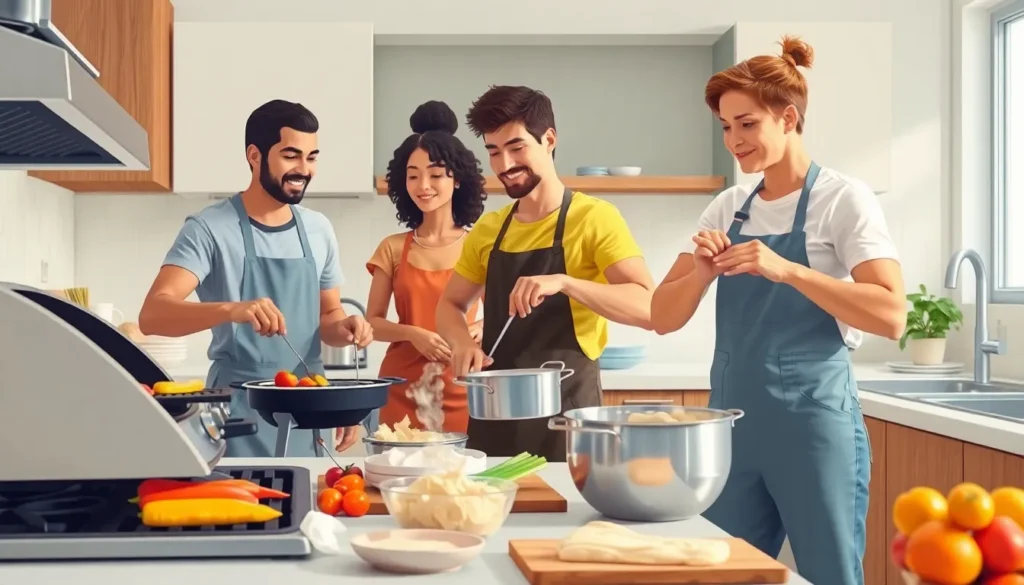Cooking isn’t just about throwing ingredients together and hoping for the best. It’s an art form, a science experiment, and sometimes, a comedy show in the kitchen. From the sizzling sound of a steak hitting a hot grill to the gentle simmer of a sauce, the methods chefs use can make or break a dish.
Table of Contents
ToggleOverview of Cooking Methods
Cooking methods encompass a variety of techniques that transform raw ingredients into flavorful dishes. Each method employs unique processes that affect texture and taste. Some common cooking methods include baking, boiling, and frying.
Baking uses dry heat in an enclosed space, typically an oven. This method excels in preparing bread, pastries, and casseroles. Boiling involves immersing food in water or broth at high temperatures, making it suitable for pasta, vegetables, and soups.
Frying, another popular method, includes both deep-frying and pan-frying. Deep-frying fully submerges food in hot oil, resulting in crispiness. Pan-frying uses less oil and cooks food over a lower flame, enhancing natural flavors.
Steaming preserves nutrients by cooking food over boiling water rather than directly in it. This method suits vegetables and fish, retaining their delicate flavors. Roasting, often done in an oven, caramelizes food while adding depth to the taste.
Grilling relies on direct heat from below, creating a smoky flavor profile in meats and vegetables. Sautéing quickly cooks food in a small amount of oil, ideal for creating flavorful bases for dishes. Braising combines both moist and dry heat, starting with browning food before slow-cooking it in liquid.
Poaching gently cooks food in simmering water or broth, perfect for delicate items like eggs and fish. Each cooking method affects the final dish’s characteristics, emphasizing the importance of technique choice. Understanding these methods enables a cook to enhance flavors and textures effectively.
Types of Cooking Methods

Cooking encompasses various techniques, each influencing flavor and texture. Understanding these methods enhances the culinary experience, leading to delicious meals.
Dry Heat Cooking
Dry heat cooking uses hot air or direct contact with heat. Techniques include baking and roasting. These methods encourage browning and flavor development. For example, roasting vegetables caramelizes their natural sugars, enhancing sweetness. Grilling, another form of dry heat cooking, imparts a smoky flavor to meats. Broiling uses high heat from above, creating a crisp exterior. Sautéing, which involves cooking food quickly in a small amount of fat, retains nutrients while achieving a rich taste. All of these methods focus on using heat without moisture to create savory dishes.
Moist Heat Cooking
Moist heat cooking utilizes steam or water to prepare food. Boiling, for instance, immerses food in hot water for cooking. This technique works well for pasta and vegetables, producing tender textures. Steaming cooks food by surrounding it with steam, which preserves nutrients and flavors. Poaching involves gently simmering food in liquid, ideal for eggs and fish, resulting in delicate outcomes. Braising combines both moist and dry heat, often starting with browning before slow cooking in a flavorful liquid. These moist heat methods contribute to a rich taste and tender culinary results.
Combination Cooking
Combination cooking merges dry and moist heat methods. Techniques like braising begin with browning and follow with moist cooking in a covered pot. This approach not only develops flavor but also tenderizes tougher cuts of meat. Another example is stewing, where food simmers in a flavorful broth after initial browning. Casseroles exemplify combination cooking, often starting with sautéing before layering ingredients in a baking dish. This blending of techniques heightens the complexity of flavors while ensuring optimal textures in the final dish.
Traditional Cooking Methods
Traditional cooking methods use age-old techniques that enhance flavors and textures. These methods focus on heat application, creating distinct outcomes in various dishes.
Boiling
Boiling involves cooking food in water or broth at high heat. This method is effective for pasta, eggs, and vegetables, often retaining nutrients when timed correctly. It allows for quick cooking and works well for soups. The bubbling action helps blend flavors, especially in stews. To achieve optimal results, maintaining a rolling boil is essential.
Steaming
Steaming cooks food by using steam from boiling water. This method preserves taste and nutrients, making it ideal for vegetables and fish. Foods become tender without direct contact with water, which prevents nutrient loss. Using a steaming basket enhances efficiency, allowing heat to circulate evenly. Resulting dishes appear vibrant and retain their natural flavors.
Baking
Baking uses dry heat in an enclosed environment, often an oven. This method relies on even heat distribution to transform ingredients into breads, cakes, and casseroles. Ingredients develop rich flavors as moisture evaporates. Perfecting baking requires precise temperatures and timing, as each component reacts differently. Bakers can experiment with various flours and flavors to create unique outcomes.
Roasting
Roasting cooks food with indirect heat, typically in an oven, which browns surfaces for enhanced taste. This method is popular for meats and vegetables, showcasing caramelization’s rich flavors. Roasting allows for even cooking, making it easy to prepare large cuts. Seasoning options are abundant, allowing for culinary creativity. As the exterior crisps, the inside remains juicy and tender.
Modern Cooking Techniques
Modern cooking techniques revolutionize the culinary landscape, providing new ways to prepare food while enhancing flavors and textures.
Sous Vide
Sous vide involves vacuum-sealing food in a bag and immersing it in a water bath at a precise temperature for an extended time. This method guarantees even cooking, tenderness, and moisture retention. Precision is key; cooking meats at lower temperatures results in perfectly cooked dishes without overcooking. Vegetables benefit from sous vide as well, maintaining natural colors and nutrients. The technique allows for consistent results, making it popular among chefs and home cooks alike. This method’s convenience lies in its ability to prepare meals in advance, so it’s perfect for busy schedules.
Microwave Cooking
Microwave cooking utilizes electromagnetic radiation to heat food quickly and efficiently. This method, which cooks food from the inside out, saves significant time compared to traditional methods. Micro-cooking maintains nutrients effectively, especially in vegetables, as it minimizes cooking duration. Convenience defines microwave use; reheating leftovers or preparing simple meals becomes effortless. Various microwave-safe containers ensure safe cooking while allowing flexibility in food choices. Understanding cooking times is crucial to avoid over- or under-cooking, providing an excellent way to speed up meal preparation.
Air Frying
Air frying uses hot air circulation to cook food, producing crispy textures without excessive oil. This technique offers a healthier alternative to traditional frying, cutting fat content significantly. Air fryers cook food quickly, making weeknight meals easier to prepare. Various foods, from chicken wings to vegetables, achieve a desirable crunch while retaining moisture. Users appreciate the ease of cleaning and versatility, with many models featuring multiple cooking functions. Mastering air frying includes adjusting temperatures and cooking times, ensuring optimal results.
Cooking Methods by Cuisine
Different cuisines utilize specific cooking methods to enhance their unique flavors and textures. Understanding these methods allows chefs to create authentic dishes that reflect cultural traditions.
Grilling
Grilling involves cooking food over an open flame or hot surface. This method produces a distinct charred flavor that enhances meats and vegetables, making it popular in various cuisines. Chefs often use marinades to infuse additional flavors before grilling. Techniques vary, with direct grilling for quick-cooking items like burgers and indirect grilling for larger cuts like whole chicken. Grilling is also a common method in outdoor gatherings, where the smoky aroma draws appetites and fosters social interaction.
Stir-Frying
Stir-frying is a quick cooking technique that uses high heat and minimal oil. This method captures the essence of Asian cuisines, particularly Chinese, allowing ingredients to maintain their color and texture. Chefs typically slice vegetables and proteins into small pieces for even cooking. A well-seasoned wok or skillet facilitates rapid cooking, where constant stirring ensures that food doesn’t stick or overcook. Stir-frying retains nutrients, making it a healthy choice for busy home cooks seeking vibrant, flavorful meals.
Braising
Braising combines both dry and moist heat, making it ideal for tougher cuts of meat. This method begins with searing the food in fat, followed by slow cooking in a covered pot with a small amount of liquid. It’s commonly used in cuisines that emphasize hearty dishes, such as French and Italian. The long, slow cooking process tenderizes the meat while allowing flavors to meld beautifully. Vegetables often accompany the braised dish, soaking up the rich sauce for a complete, balanced meal.
Health Considerations in Cooking Methods
Cooking methods significantly influence the nutritional quality of food. Grilling, for example, reduces fat content as excess grease drips away, promoting healthier meals. Steaming preserves more nutrients compared to boiling, making it an optimal choice for vegetables.
Frying, whether deep or pan-frying, often increases calorie content due to added oils. Air frying, however, provides a healthier alternative using hot air to achieve crispy textures with minimal oil. Baking maintains moisture in foods, but it can lead to higher carbohydrate intake when preparing bread and pastries.
Boiling focuses on preserving flavors while cooking foods quickly, though overcooking can result in nutrient loss. Sous vide utilizes precise temperature control, ensuring even cooking and preventing nutrient degradation. Combining dry and moist techniques, such as in braising, allows tougher meats to become tender while enhancing flavors.
Slow cooking fosters tenderness in ingredients, but monitoring cooking times is crucial to avoid nutrient loss. Roasting intensifies flavors through caramelization but may also lead to the formation of harmful compounds if temperatures are too high.
For those prioritizing health, choosing the right method can minimize harmful substances and maximize nutrient retention. Each technique varies in its health implications, highlighting the importance of selecting methods aligned with nutritional goals. Understanding these impacts leads to healthier eating patterns and better meal choices.
Exploring various cooking methods reveals the intricate relationship between technique and flavor. Each method offers unique advantages that can elevate a dish from ordinary to extraordinary. Whether it’s the crispiness achieved through air frying or the tenderness from braising, understanding these techniques empowers cooks to create meals that delight the palate.
Adopting a variety of cooking methods not only enhances culinary skills but also promotes healthier eating habits. By choosing the right technique for each dish, individuals can maximize taste while minimizing nutritional loss. Embracing the art and science of cooking opens up a world of possibilities in the kitchen, making every meal an opportunity for creativity and enjoyment.





